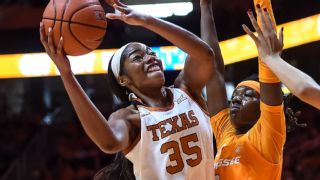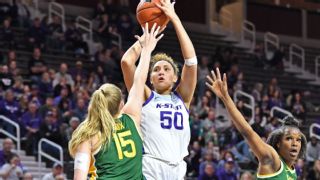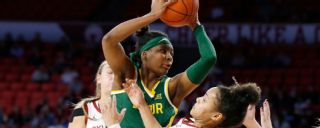|
As the countdown continues to the start of the 2020-21 women's college basketball season on Nov. 25, ESPN.com's panel of experts is making its predictions for all of the nation's top conferences. We begin with the Big 12, in which the Baylor Lady Bears remain the reigning national champion and look to continue their dominance over the rest of the league. The Iowa State Cyclones and Texas Longhorns, under new coach Vic Schaefer, look to end Baylor's run of 10 consecutive Big 12 regular-season titles. Jump to: Superlatives | Roundtable
Biggest Bracketology question | Picks
Big 12 2020-21 superlativesPlayer of the Year Mechelle Voepel: NaLyssa Smith, Baylor
Graham Hays: Ashley Joens, Iowa State
Charlie Creme: Ashley Joens, Iowa State Newcomer of the Year Voepel: DiJonai Carrington, Baylor
Hays: DiJonai Carrington, Baylor
Creme: DiJonai Carrington, Baylor
Big 12 2020-21 writer roundtableWhat are reasonable expectations for Vic Schaefer in his first season at Texas?Hays: Mississippi State had a 13-17 record in its first season under Schaefer, which was actually one fewer win than the season before he arrived and included losses against Hampton, UC Santa Barbara and Winthrop. It wasn't until his second season that the Bulldogs won 20-plus games -- and the season after that they had a winning SEC record. Schaefer will build things in Austin according to his vision, even if implementing that comes with short-term growing pains. A deep run in the NCAA tournament this season probably isn't a reasonable expectation. That said, the collective talent in Austin exceeds what he inherited in Starkville. Enough remains from a team that won 19 games last season to provide a base for success, but there is also enough turnover to open up the depth chart to competition without stepping on toes. Challenge Iowa State as the best non-Baylor team in the Big 12 and win an NCAA tournament game. If that's where Schaefer starts, the larger project will already be in excellent shape.  Creme: Schaefer grew the program quickly at Mississippi State. He will do it even faster at Texas. This season, however, will have some ups and downs. The Longhorns performed inconsistently in Karen Aston's last couple of years and Schaefer won't be able to change that overnight, but enough talent remains to profoundly exceed what he did in his first season with the Bulldogs in 2011-12. In junior forward/center Charli Collier and sophomore guard Celeste Taylor, he has players who were once high school McDonald's All Americans. That kind of foundation didn't exist in Starkville when he arrived. With Schaefer's ability to get the most out of all of his players, Texas should finish second or third in the Big 12. I'll even take take Graham's assessment one step further and say the Longhorns will finish ahead of Iowa State in second place in the Big 12. Texas is not ready to complete with Baylor for the top spot and might not be for a few years. But that is why Schaefer was brought to Austin. Eventually, it should happen. Voepel: Schaefer himself says he didn't come to Texas to be good. He came to be great. The program last went to the Final Four in 2003, and that has to be the goal soon. In 2017, Mississippi State made its first Final Four appearance in Dallas -- which is host to the Final Four again in 2023. So there could be some symmetry there. But as for this season, Schaefer will want to first establish that the Longhorns can play the kind of energetic, athletic defense that will frustrate other teams, and then build from there. It was hard to know what to make of Texas last season. The Longhorns beat Tennessee and Stanford in nonconference play but lost in the Big 12 to the league's worst team, Kansas, on the road by 15 points. Three starters are gone from that team, including Joyner Holmes and Sug Sutton, both of whom played in the WNBA this season. So Texas lost some good talent, but there is still plenty remaining in Austin. It feels like the right time to turn the page for the program, and a top-three finish would be a very strong way to start the Schaefer era. The transition back into the Big 12, where he was a longtime assistant to Gary Blair at Texas A&M, won't be difficult for Schaefer. Coaches like Baylor's Kim Mulkey, Iowa State's Bill Fennelly and Oklahoma's Sherri Coale, whom Schaefer went against while with the Aggies, are still in the league. A lot of this will feel familiar to him. Where does this season rank among Kim Mulkey's reloading projects?Hays: In terms of Mulkey's challenges since Baylor won its first championship, I'd rank this season as second only to 2014-15. That was the season after Odyssey Sims departed, ending an era in which Sims and Brittney Griner went 108-5 together and Baylor went 167-20 with at least one of them around. Baylor went 33-4 in 2014-15 with then-sophomore Nina Davis as its lone double-digit scorer, and that remains one of the best entries on Mulkey's résumé. It isn't that the current Baylor roster lacks talent, but there are only four players remaining who were major parts of the rotation en route to the 2018-19 national title that Baylor is still technically defending. Te'a Cooper, Lauren Cox and Juicy Landrum were valuable beyond statistical measure (and accounted for 41% of Baylor's points and 49% of its assists). Asking DiDi Richards to transition to point guard, acclimating a third significant grad transfer in as many years in DiJonai Carrington and working in freshmen Sarah Andrews and Hannah Gusters makes for a lot of moving parts. Richards is out indefinitely with no specified time to return to basketball activities after suffering a spinal-cord injury without radiographic abnormality in practice last week. Creme: I second Graham's assessment that 2014-15 was a bigger task. Heading into that season, I projected Baylor as a No. 3 seed and the No. 12 overall team on my board. This season's team, despite the losses of Cox, Cooper and Landrum, still is slotted as a preseason No. 1 seed. Few expected Nina Davis to be as incredibly productive as she was that season as a sophomore, but there are expectations for juniors NaLyssa Smith and Queen Egbo this time. The key will be Richards' transition to point guard. She is capable and has been in the program for three years, unlike the graduate transfers who have taken up that role the past two seasons. This is where the truncated season and limited nonconference competition might hurt Baylor more than some of the other top national title contenders. If this ultimately becomes Mulkey's toughest rebuilding job, it might be more because of circumstance than personnel. Voepel: Baylor's business-as-usual success in 2014-15 was a gut punch to the rest of the Big 12, which had been waiting for some kind of drop-off from the Lady Bears after the end of the Griner-Sims era. Didn't happen. But the Big 12's veteran coaches also kind of had to expect that. Go back to the 2006-07 season, after Baylor lost three starters that had been on the 2005 championship team, led by future WNBA standout Sophia Young. Even then, Baylor won 26 games and finished third in the league. And in 2009-10, after Baylor had lost four starters from the previous year and was depending on the talented freshman Griner, the Lady Bears finished sixth in the Big 12, yet reached the Final Four. Consistently reloading no matter the personnel losses is really hard, but Baylor is one of just a handful of programs that has made it look relatively easy for the past 15-plus years. That shouldn't obscure the difficulty of the job Mulkey has in front of her. Cox, even with the injury issues she dealt with last season, was still the league's best player, and throughout her Baylor career made everyone else on the floor better. Landrum was a dependable guard who knew her role, and Cooper made the most of her one season at Baylor. Richards had a ton on her plate before her injury in practice Oct. 24; now it's uncertain when she'll return. Considering the injury involved her spinal cord, one assumes Baylor will be very conservative and careful about when she comes back. Point guard becomes even more of a question, which puts more weight on the shoulders of Baylor's junior posts Smith and Egbo to lead the way. Who is the best 'big' in the Big 12?Hays: It's a throwback to see a conference with so many good post players. If forced to pick only one, I'll go with Kansas State's Ayoka Lee. That decision is easier if you take eligibility into account, given that she has three seasons still to play (or possibly even four if she uses the extra year recently granted to all winter-sports athletes). Kansas State probably was headed to the WNIT a season ago after going 4-1 down the stretch, including wins at Texas and against Iowa State. Lee was instrumental in both results and picked up both her raw scoring and offensive efficiency in conference play -- despite Kansas State playing a relatively modest nonconference schedule. It's that offensive potential, along with the rebounding and defense that all the Big 12 bigs have, that catches the eye.  Creme: Both Lee and Oklahoma State's Natasha Mack generated incredible production for players getting their first taste of Division I basketball. Both averaged double-doubles and carried a major load for their respective teams. So it comes down to those two for me. Perhaps that measuring stick is a bit unfair to Egbo, who got far fewer opportunities to produce because of the quality of players around her. As more of a focal point of Baylor's offense, Egbo could significantly elevate. But my vote goes to Mack because of her work on defense. Her 17.6 PPG and 12.5 RPG -- and the 26-point, 13-rebound game against Oregon and 19 and 16 against Texas A&M -- were impressive enough. But Mack, the 2019 national junior college player of the year, also finished third in the country with 3.6 blocks per game, led the Cowgirls with 50 steals and was named to the Big 12 all-defensive team. With Vivian Gray leaving Oklahoma State for Texas Tech, even more might be asked of Mack in 2020-21. How she handles that added pressure in her senior season might determine whether she also gets the nod as the best "big" in the Big 12 come March. Voepel: While Baylor's Smith and Iowa State guard/forward Ashley Joens seem likely to battle for Big 12 player of the year honors, the competition for best forward/center could be just as intriguing. For true "big" -- as in a predominantly low-block threat -- I lean toward K-State's Lee, one of the top freshmen in the country last season. But I also want to mention Texas' Collier, a 6-foot-5 post player who has 3-point shooting ability (28 of 79 treys last season). We haven't seen the best of her yet, and it will be interesting to see how she develops in Schaefer's system.
What's the biggest preseason Bracketology question in the Big 12?Creme: Only four Big 12 teams were likely headed to last season's NCAA tournament. Only three -- Baylor, Iowa State and Texas -- appear to be locks this season. Can the middle of the conference improve enough in 2020-21 to get five, six or even seven teams in the field? Improvement is the operative word. The Big 12 just wasn't very good in 2019-20. Not only was the league projected to get only four teams into the tournament, but Iowa State and Texas were looking at seeds in the No. 9 and No. 10 range. If that is to be better in 2021, the key might lie in two programs: Kansas State and West Virginia. Last season, the Wildcats, at least partially due to injury, dug themselves too great a hole from which to climb, and the Mountaineers faded badly in the season's final five weeks. Both should be better this season. West Virginia has three of its top four scorers back and coach Mike Carey added more depth, including former Tennessee player of the year and Mississippi State transfer Jayla Hemingway. Kansas State has Lee to build around and significant experience in the backcourt, led by Rachel Ranke (back from injury) and Sydney Goodson (Texas Tech transfer). Right now both project as bubble teams. Building an NCAA tournament résumé -- and this goes for every team in the Big 12, including other tournament hopefuls Oklahoma, Texas Tech and TCU -- is going to be far more dependent on winning in the league with only six or seven available nonconference games. The Big 12 is top heavy with Baylor, and the conference has lacked balance for a long time. But if we get to March and there are a bunch of Big 12 teams with 9-9 conference records, that would hurt, not help. Having 10-12 wins is going to be a must.
Big 12 2020-21 predicted order of finish
|

